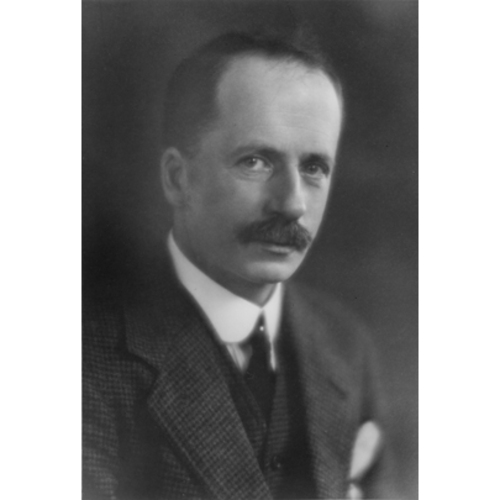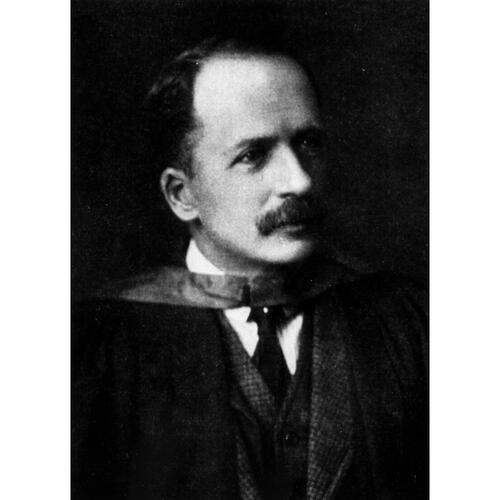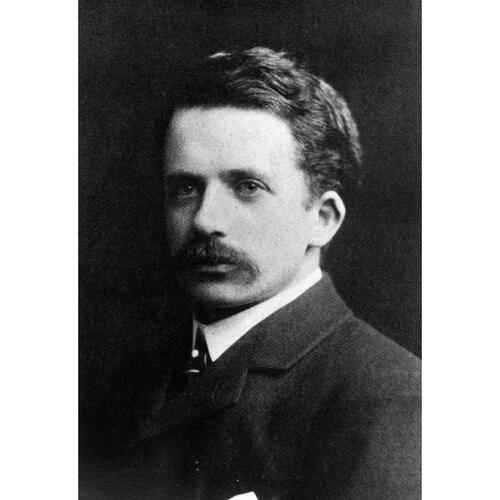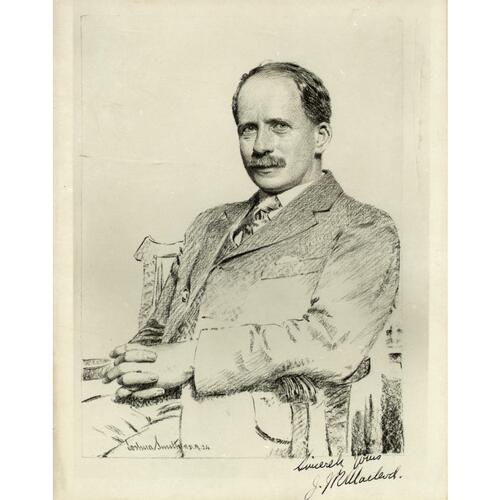![John James Rickard MacLeod, [1925?]. Robert Lansdale Photography Ltd. UTARMS, A1978-0041/014(35). Original title: John James Rickard MacLeod, [1925?]. Robert Lansdale Photography Ltd. UTARMS, A1978-0041/014(35).](/bioimages/w600.11265.jpg)
Source: Link
MACLEOD, JOHN JAMES RICKARD, physiologist, university teacher, author, and Nobel laureate; b. 6 Sept. 1876 in Clunie, parish of Caputh, Perthshire, Scotland, eldest child of the Reverend Robert Macleod and Jane Guthrie McWalter; m. 22 July 1903 Mary Watson McWalter, a second cousin, in Paisley, Scotland; they had no children; d. 16 March 1935 in Bieldside (Aberdeen), Scotland.
A son of the manse, J. J. R. Macleod chose science as his profession and North America as his home. He was educated at the Aberdeen Grammar School and in medicine at Marischal College, University of Aberdeen. After graduate studies at Leipzig and Cambridge and a brief appointment at the London Hospital Medical College, he emigrated in 1903 to become professor of physiology at Western Reserve University in Cleveland, Ohio. Over the next 15 years he proved himself a prolific researcher, a learned professor, and an accomplished scientific writer at both the advanced and the introductory levels. His research interests came to centre on metabolism, with special emphasis on the body’s use of carbohydrates. His early books included Diabetes: its pathological physiology (London, 1913) and what became a standard textbook, Physiology and biochemistry in modern medicine (St Louis, Mo., 1918).
Partly out of a desire to return to British soil, as Canada was then perceived, Macleod accepted the offer of the chair in physiology at the University of Toronto in 1918. It was a prestigious appointment at a major institution committed to developing its capacity for advanced research. He appears to have been a popular and highly competent professor and administrator during a period when the faculty of medicine and his department were experiencing considerable growth and modernization, spiced by controversial issues ranging from terms of appointment to the treatment of laboratory animals. He had at his disposal exceptionally good research facilities and support, and was satisfied enough with his position to refuse a request to become a candidate for the widely esteemed chair of physiology at Johns Hopkins Hospital and school of medicine.
On 8 Nov. 1920 Macleod was asked by Frederick Grant Banting*, a medical graduate of the University of Toronto, if he could make facilities available for Banting to test an idea he had developed to try to isolate the long-sought internal secretion of the pancreas, a substance which, if it existed, appeared to be necessary for normal metabolism, particularly the avoidance of diabetes mellitus. Macleod told the young doctor, who knew little about research and less about diabetes, that he would probably achieve negative results with the idea, but he agreed that even these would make it worth trying. If the work accomplished nothing else, Macleod knew he had a mandate from the university to develop its research capacity. When Banting came back to Toronto in May 1921, Macleod assigned him laboratory space, a supply of dogs to use in his experiments, and the services of his student assistants over the summer. He instructed Banting on surgical procedures and on the plan of research before leaving for Scotland in mid June.
When Banting and his assistant, Charles Herbert Best*, reported positive results to Macleod later that summer and on his return to Toronto in September, he advised them to repeat and refine their experiments so as to build a convincing case that the elusive secretion was being located. As head of the lab, he rejected Banting’s demands for priority for his project, but he gradually became increasingly interested in what seemed to be a pattern of favourable results. In December he acceded to Banting’s request to add an experienced biochemist, James Bertram Collip*, to the team, and he sponsored a report on Banting and Best’s experiments to the American Physiological Society on 30 December.
As formal director of the research project, Macleod arranged the clinical trials on human subjects that began in January 1922 and showed spectacular success after Collip succeeded in purifying Banting and Best’s extracts (first of dog and then of beef and pork pancreas), which had often, though not always, been successful on dogs. A fast-moving, exciting scientific adventure suddenly became terribly enmeshed in personal antagonisms when Banting began accusing Macleod and Collip of appropriating credit for his discovery. As he steered the investigation towards triumphant publication later that spring, Macleod had to arbitrate violent conflict between Banting and Collip, while also defending himself against Banting’s charges of unethical behaviour.
In 1922–23 Macleod organized ongoing research into the characteristics of the substance he suggested be called insulin (after the islet cells in the pancreas where the group assumed it was produced; he subsequently realized that earlier researchers had suggested a similar name for the hypothetical secretion), packaged and presented the discovery to the scientific world, and negotiated a delicate course through early production problems and clinical trials. He maintained his equanimity through a series of further misunderstandings with Banting. While Banting and his friends were able to convince Canadian authorities that there was only one principal discoverer of insulin (with some help from Best), other scientists and the Nobel Committee for Physiology or Medicine in Sweden concluded that Banting could not have reached insulin without Macleod’s guidance and recommended that the 1923 prize be awarded jointly to Banting and Macleod. Banting divided his prize money equally with Best; Macleod split his with Collip.
Macleod continued to supervise important ongoing research into the physiology of insulin at Toronto, but found the atmosphere poisoned by Banting’s continuing rancour. Perhaps also eager to return to his native land, he left Canada in 1928 to become regius professor of physiology at the University of Aberdeen. Fully honoured in Scotland, Macleod made further useful research contributions; his return to an earlier interest in the possibility of neurogenesis of diabetes led some of his students, such as Hans Kosterlitz, to become pioneers in work on endorphins many years later. In semi-retirement Macleod was a gentle, quiet man and a lover of music and art, especially Canadian painting (in Toronto he had briefly been a member of the city’s Arts and Letters Club). He died from the effects of arthritis in 1935.
The persistence in popular and even some scientific circles of the view that Macleod had stolen credit from Banting and Best continued to cloud his reputation. Serious historical reconsideration began after the death of Best in 1978 and the ensuing publication of Macleod’s 1922 account of the events in Toronto. It is now recognized that Macleod, along with Collip, played an essential role in the discovery of insulin. The event emerges as an early example of a breakthrough achieved by scientific collaboration – fractiousness notwithstanding – in a well-equipped research university. An expert, cautious, patient, and wise scientist, J. J. R. Macleod gradually became recognized even in Canada and at the University of Toronto for his leadership in the finest research achievement in the country during the 20th century.
In addition to the titles mentioned in the biography, J. J. R. Macleod is the author or co-author of 9 monographs and some 200 scientific papers. Details about much of his published work appear in M. J. Williams, J. J. R. Macleod: the co-discoverer of insulin (Edinburgh, 1993), a slightly hagiographic but generally thorough and authoritative biography. Numerous of his publications during and after the insulin research in Toronto contain brief, carefully phrased accounts of the work, most notably, J. J. R. Macleod and W. R. Campbell, Insulin: its use in the treatment of diabetes (Baltimore, Md, 1925). His long-suppressed, 5,000-word memoir of his role in the discovery, written in September 1922 at the invitation of Albert Edward Gooderham, chairman of the Univ. of Toronto’s insulin committee, was published as “History of the researches leading to the discovery of insulin,” intro. L. G. Stevenson, Bull. of the Hist. of Medicine (Baltimore), 52 (1978): 295–312. It may be compared with “Banting’s, Best’s, and Collip’s accounts of the discovery of insulin,” intro. Michael Bliss, Bull. of the Hist. of Medicine, 56 (1982): 554–68.
Extensive enquiries in Scotland and Canada have failed to uncover a major collection of Macleod papers. A substantial amount of his correspondence during the insulin years survives in the Charles Herbert Best papers (ms coll. 241) in the Thomas Fisher Rare Book Library, Univ. of Toronto. A number of the letters, along with details of the Fisher Library’s other extensive insulin collections, notably the Sir Frederick Grant Banting papers (ms coll. 76), are available online at the Univ. of Toronto Libraries, Fisher Library Digital Coll., “The discovery and early development of insulin”: link.library.utoronto.ca/insulin (consulted 5 Nov. 2014).
The standard published history of the research, which draws on all the primary sources, is Michael Bliss, The discovery of insulin (Toronto, 1982; 25th anniversary ed., 2007). Special attention to Macleod’s scientific career before and after insulin is given in Michael Bliss, “J. J. R. Macleod and the discovery of insulin,” Quarterly Journal of Experimental Physiology (Cambridge, Mass.), 74 (1989): 87–96. The discovery is set in the context of the history of the Univ. of Toronto and its medical faculty in M. L. Friedland, The University of Toronto: a history (Toronto, 2002).
NRS, SR Births, Caputh (Perth), 6 Sept. 1876; SR Deaths, Peterculter East (Aberdeen), 16 March 1935; SR Marriages, Paisley (Renfrew), 22 July 1903.
Cite This Article
Michael Bliss, “MACLEOD, JOHN JAMES RICKARD,” in Dictionary of Canadian Biography, vol. 16, University of Toronto/Université Laval, 2003–, accessed December 23, 2025, https://www.biographi.ca/en/bio/macleod_john_james_rickard_16E.html.
The citation above shows the format for footnotes and endnotes according to the Chicago manual of style (16th edition). Information to be used in other citation formats:
| Permalink: | https://www.biographi.ca/en/bio/macleod_john_james_rickard_16E.html |
| Author of Article: | Michael Bliss |
| Title of Article: | MACLEOD, JOHN JAMES RICKARD |
| Publication Name: | Dictionary of Canadian Biography, vol. 16 |
| Publisher: | University of Toronto/Université Laval |
| Year of publication: | 2018 |
| Year of revision: | 2018 |
| Access Date: | December 23, 2025 |






